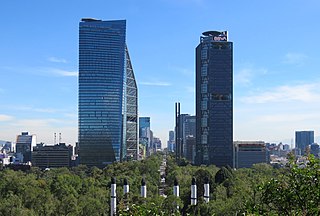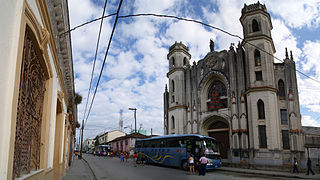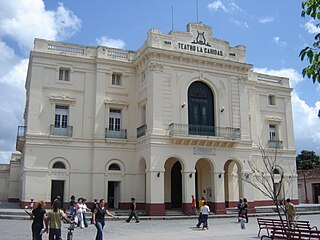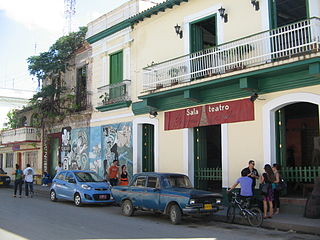
Paseo de la Reforma is a wide avenue that runs diagonally across the heart of Mexico City. It was designed at the behest of Emperor Maximilian by Ferdinand von Rosenzweig during the era of the Second Mexican Empire and modeled after the great boulevards of Europe, such as the Ringstraße in Vienna and the Champs-Élysées in Paris. The planned grand avenue was to link the National Palace with the imperial residence, Chapultepec Castle, which was then on the southwestern edge of town. The project was originally named Paseo de la Emperatriz in honor of Maximilian's consort Empress Carlota. After the fall of the Empire and Maximilian's subsequent execution, the Restored Republic renamed the Paseo in honor of the La Reforma.

Santa Clara is the capital city of the Cuban province of Villa Clara. It is centrally located in the province and Cuba. Santa Clara is the fifth-most populous Cuban city, with a population of nearly 245,959.

Miramar is a residential district of the municipality of Playa, in the city of Havana.

Colón is a municipality and city in the Matanzas Province of Cuba. The municipality has an area of 547 km2 (211 sq mi) and a population of about 68,021. The city proper, with a population of about 44,000, is the third-largest of its province.

Plaza Las Delicias is the main plaza in the city of Ponce, Puerto Rico. The square is notable for its fountains and for the various monuments it contains. The historic Parque de Bombas and Ponce Cathedral buildings are located within the plaza, which actually consists of two squares: Plaza Muñoz Rivera on the north end, and Plaza Degetau on the southern end. The square is the center of the Ponce Historic Zone, and it is flanked by the historic Ponce City Hall to the south, the early 19th-century Teatro Fox Delicias to the north, the NRHP-listed Banco Crédito y Ahorro Ponceño and Banco de Ponce buildings to the east, and the Armstrong-Poventud Residence to the west. The square dates back to the early Spanish settlement in Ponce of 1670. It is the main tourist attraction of the city, receiving about a quarter of a million visitors per year.
Parque del Carmen is a park in Santa Clara, Cuba, which honors the city's founding. It is located in the ward (reparto) El Carmen, not too far from Martyr's Park and the railway station.

Parque de los Mártires is a park in Santa Clara, Cuba. It is a few blocks from Parque del Carmen in front of Santa Clara railway station.

The Catedral de Santa Clara de Asís is a Roman Catholic cathedral located in the city of Santa Clara, Cuba. It lies on Calle Marta Abreu, one of the city's main arteries, only two blocks from Parque Vidal and next to the cultural centre "El Mejunje".

Ciudad Colonial is the historic central neighborhood of the Dominican Republic's capital Santo Domingo. It is the oldest continuously inhabited European-established settlement in the Americas. The area has been declared a World Heritage Site by UNESCO. It is also known as Zona Colonial or more colloquially as "La Zona".

Marta Abreu de Estévez was one of the most influential figures of her time in central Cuba, especially in her birth city and province of Santa Clara. For her constant aid to the poor, her donations to the city and the independence war, she won the title of "the great benefactor".

Teatro de La Caridad or Teatro La Caridad, located in Santa Clara, is one of the few remaining colonial theatres in Cuba. It is a National Monument of Cuba.

The Boy with the Leaking Boot is a statue showing a young boy, with a bare right foot, holding up his right boot and looking at it. The statue is about 4 feet (1.2 m) tall, and in many cases forms a fountain, with water emerging from the toe of the boot. There are at least 24, and reportedly "hundreds" of examples. The origins of the statue are obscure. The boy is reported to be a young Italian newspaper seller who drowned, or an American army drummer-boy who carried water in his leaking boot to help fallen comrades, or a young fire-fighter either using his boot in a bucket chain or emptying his boot after an incident, or possibly none of these. The statue has also been called The Boy with the Leaky Boot, Boy Immigrant and Unfortunate Boot.

Plaza Degetau, formally Plaza Federico Degetau, is the larger of two plazas at Plaza Las Delicias, the main city square in the city of Ponce, Puerto Rico. The other plaza is named Plaza Muñoz Rivera and is located north of Plaza Degetau. The square is notable for its fountains and for the various monuments it contains. The historic Parque de Bombas and Ponce Cathedral buildings are located bordering the north side of this plaza. The square is the center of the Ponce Historic Zone, and it is flanked by the historic Ponce City Hall to the south, the cathedral and historic firehouse to the north, the NRHP-listed Banco Crédito y Ahorro Ponceño and Banco de Ponce buildings to the east, and the Armstrong-Poventud Residence to the west. The square dates back to the early Spanish settlement in Ponce of 1670. It is the main tourist attraction of the city, receiving about a quarter of a million visitors per year.

Santa Clara is the main railway station of the city of Santa Clara, seat of Villa Clara Province, Cuba. It is owned by the state company Ferrocarriles de Cuba (FFCC) and is located in front of Parque de los Mártires. It is one of the most important stations of Cuba and, along with Havana Central, Santiago and Camagüey, is a network's divisional headquarters.
Leoncio Vidal y Caro was a Cuban revolutionary that fought in the Cuban War of Independence. A colonel, he fell in battle in Santa Clara, Cuba. He is considered a hero in Cuba and the Parque Vidal in Santa Clara was named in his honor. Vidal was the uncle of General Emilio Mola.

El Mejunje, also known as El Mejunje de Silverio after the surname of its founder and director, Ramón Silverio, is a Cuban LGBT cultural center and space located in the city of Santa Clara. It lies on the central Calle Marta Abreu, near the corner with Calle Juan Bruno Zayas, close to the Parque Vidal and La Caridad Theatre, next to the Saint Claire of Assisi Cathedral.

The Parque Central, Havana is one of the best known and central sites of the city of Havana, Cuba. It is located between Prado, Neptuno, Zulueta and San José streets, and San Rafael Boulevard. Among the buildings surrounding the park are Gran Teatro de La Habana, the Hotel Inglaterra, the Hotel Telégrafo, el Hotel Parque Central, la Manzana de Gómez, the Hotel Plaza and Museo Nacional de Bellas Artes.

Valencian Art Nouveau is the historiographic denomination given to an art and literature movement associated with the Art Nouveau in the Valencian Community, in Spain.

The Soldiers' Monument is a cenotaph at the center of the Santa Fe Plaza, a monument collectively memorializing deaths in several specified battles. It is obscured from public view and access by concreteboard walls used as a preservation measure. Erected during the late 1860s in the aftermath of the American Civil War, it consisted of a 33 feet (10 m) stone obelisk atop a plinth; only the plinth stands currently, and exhibits some damage. During the late nineteenth century, the monument was used as a place for Union veterans to gather at annual Memorial Day events to decorate the cenotaph and hear brief presentations.
























